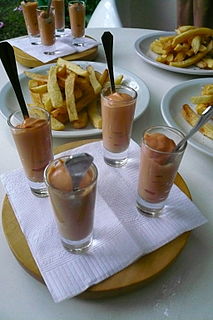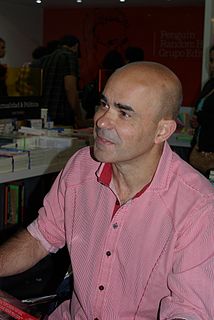Related Research Articles

Spanish cuisine is heavily influenced by historical processes that shaped local culture and society in some of Europe's Iberian Peninsula territories. Geography and climate have had a great influence on cooking methods and available ingredients. These cooking methods and ingredients are still present in the gastronomy of the various regions that make up Spain. Spanish cuisine derives from a complex history where invasions and conquests of Spain have modified traditions, which made new ingredients available. Thus, the current and old cuisine of Spain incorporates old and new traditions.

Ceviche, also cebiche, seviche, or sebiche typically made from fresh raw fish cured in fresh citrus juices, most commonly lemon or lime, and spiced with ají, chili peppers or other seasonings including chopped onions, salt, and coriander.

Feijoada is a stew of beans with beef and pork. It is commonly prepared in Portugal, Brazil, Angola, Cape Verde, Guinea-Bissau, Mozambique, Timor, Goa, and Macau, where it is also considered a national dish. However, the recipe differs slightly from one country to another.

Pabellón criollo is a traditional Venezuelan dish, the local version of the rice and beans combination found throughout the Caribbean. It is a plate of rice, shredded beef in stew and stewed black beans.

Nicaraguan cuisine includes a mixture of indigenous Native American cuisine, Spanish cuisine, and Creole cuisine. Despite the blending and incorporation of pre-Columbian and Spanish-influenced cuisine, traditional cuisine differs on the Pacific coast from the Caribbean coast. While the Pacific coast's main staple revolves around beef, poultry, local fruits, and corn, the Caribbean coast's cuisine makes use of seafood and coconut.

Jorge Majfud is a Uruguayan American writer.

Arroz con pollo is a traditional dish of Spain and Latin America, closely related to paella. In the Dominican Republic it is alternately called locrio de pollo, and in Saint Martin it is called lokri or locreo.

Manchego cuisine refers to the typical dishes and ingredients in the cuisine of the Castilla–La Mancha region of Spain. These include pisto, gazpacho manchego, Manchego, the white wine of La Mancha, and the red wine from Valdepeñas (DO).

Salsa golf is a cold sauce of somewhat thick consistency, common in Argentina. According to legend, it was invented by Nobel laureate Luis Federico Leloir in the mid-1920s at a golf club at the seaside resort Mar del Plata copying the famous "salsa rosada" from Colombia, which was invented around 1916. Tired of eating shrimp and prawn with mayonnaise, he asked the waiter to bring various ingredients and experimented with different mixtures. The best-liked was ketchup and mayonnaise. Leloir's companions named the result salsa golf, and its fame grew. Soon it also spread to neighboring Uruguay.
Tulio Halperín Donghi was an Argentine historian. He obtained a Ph.D in history and a law degree at the University of Buenos Aires, then taught at the institution's Faculty of Arts. from 1955-1966. Donghi moved to the National University of the Litoral, where he was named dean. Donghi later taught at the University of Oxford, and became a faculty member of the University of California, Berkeley in 1972.
The 9th annual Billboard Latin Music Awards, which honor the most popular albums, songs, and performers in Latin music, took place May 9 in Miami. Winners are determined by the actual sales and radio airplay data that informs Billboard's weekly charts, including Top Latin Albums, and radio charts, including Hot Latin Tracks, during a one-year period from the issue dated Feb. 17, 2001 through the Feb. 9, 2002, issue.
The 2010–11 Nicaraguan Professional Baseball League season finished with the Indios del Bóer winning the competition.
Run down, also referred to as rundown, run dun, rondón, fling-me-far and fling mi for is a stew dish in Jamaican cuisine and Tobago cuisine. The traditional Jamaican dish is eaten in several Latin American countries that share a coast with the Caribbean Sea.

Miss World 2014, the 64th edition of the Miss World pageant, was held on 14 December 2014 at the ExCeL London in London, United Kingdom. 121 contestants competed for the crown. Megan Young of the Philippines crowned her successor Rolene Strauss of South Africa at the end of the event. This is the second time that South Africa has won the title outright and the third time they have held the title.
Marisela de Montecristo is a Salvadoran model, television presenter, actress, and beauty pageant titleholder who has been crowned Nuestra Belleza Latina 2013 and Miss El Salvador 2018.

Eduardo Alfredo Sacheri is an Argentine writer and professor of History, graduated in the National University of Luján. He is best known for his novel La pregunta de sus ojos which became the basis for the Oscar-winning film El secreto de sus ojos and its American remake. Sacheri co-wrote the film's script in collaboration with its director Juan Jose Campanella. Sacheri and Campanella were also the screenwriters of the animation film Underdogs. He also published a number of short stories, such as Esperándolo a Tito y otros cuentos de fútbol and Lo raro empezó después.
The Premio Biblioteca Breve is a literary award given annually by the publisher Seix Barral to an unpublished novel in the Spanish language. Its prize is €30,000 and publication of the winning work. It is delivered in February, to a work from the preceding year.

Choricero peppers are a variety of red pepper that are dehydrated for preservation. They have become part of Spanish culture, so much so that their hydrated pulps are simply kept in glass jars for aesthetic purposes.

Causa limeña or simply causa, is a typical and widespread entrée of the Peruvian gastronomy which has a pre-Columbian origin.
References
- ↑ Raquel Roque (4 September 2013). Cocina Latina: El sabor del mundo latino. Penguin Publishing Group. pp. 357–. ISBN 978-1-101-55290-2.
- ↑ Enrique Peña Hernández (1968). Folklore de Nicaragua. Editorial Unión. p. 193.
- ↑ "Indio viejo | Traditional Stew From Nicaragua | TasteAtlas". www.tasteatlas.com.
- ↑ "Indio Viejo Recipe". March 17, 2016.
- ↑ Behnke, Alison; Chacon, Griselda Aracely (January 1, 2005). Cooking the Central American Way. Lerner Publications. ISBN 9780822512363 – via Google Books.
- ↑ Roque, Raquel (September 4, 2013). Cocina Latina: El sabor del mundo latino. Penguin. ISBN 9781101552902 – via Google Books.
| This Nicaragua-related article is a stub. You can help Wikipedia by expanding it. |